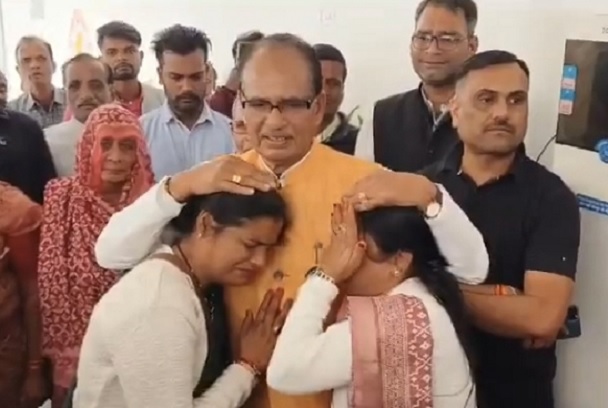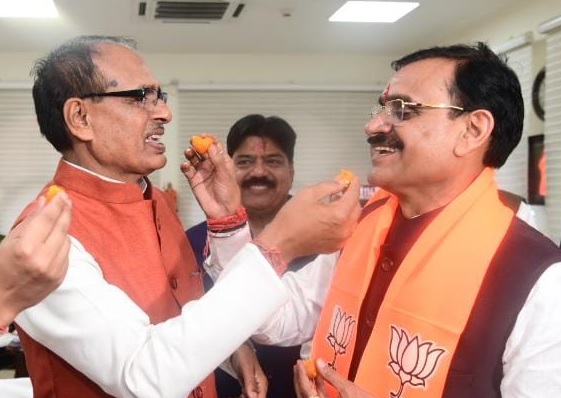‘Food from our kitchen the best’: Experts suggest home cooked local produce based food for good health

Senior Correspondent
NewsBits.in
BHOPAL: ‘If we want to stay healthy and give better health to our future generations, then the best way is to cook and eat the produce available inour homes and communities in our own kitchen. Processed and packaged food items available in the market are full of extremely harmful elements.’
This conclusion emerged from the extensive discussion session titled 'Hum, Bharat Ke Log Aur Hamari Poshan Bhari Rasoi' (We people of India and our kitchens full of nutrition) organized on March 7 ahead of the International Women's Day.
On this occasion, a book related to community nutrition titled 'Hamari Poshan Bhari Rasoi' (Our kitchen full of nutrition) and another titled 'Bachpan Mein Samvidhan' (Constitution in childhood) were also released.
Delivering the welcome address, Vikas Samvad Director Sachin Kumar Jain said that the market is greatly influencing our food and nutrition. Efforts are being made to deal with this at the policy level, but at the individual level, our livelihood levels also affect nutrition.
Underlining the importance of festivals, he said, “Our festivals and celebrations cannot be seen separately from rivers, forests and food. Any festival, be it Baisakhi, Pongal or Bihu - the major festival of every region of the country is linked to crop production, climate and natural resources. We celebrate both the occasions of beginning and ending of crop cycles. But in the last three-four decades, our eating habits have changed due to the interference of the market.”
About the book 'Hamari Poshan Bhari Rasoi', he said “when we talk about diversity of nutrition, there is a need to recognize the ways of eating in the society. It is important to know where our food comes from and in which dishes it is used. An attempt has been made to compile such recipes in this book. We believe that nutrition is a science and in this science, there is a need to recognize the role of food producers and people associated with the kitchen.”
In the opening session of the programme, Joint Director of Madhya Pradesh Women and Child Development Department, Suresh Tomar said, “From my experience so far, I can say with full confidence that I have learnt the most from Anganwadi workers because their knowledge is the most practical. We need to learn from those who work on the ground regarding nutrition. The market wants us to buy all the nutritional items like milk, grains, fruits, vegetables etc. from it. We have to discuss with the community underlining that nutritious food can also be grown in our farms, home gardens etc. and with more purity.”
Writer Vibha Varshney, who came from New Delhi, said that instead of packaged food, we should include things grown in and around our home in our diet. She said, “I was very happy to see from the book released here that there is so much awareness about nutrition in remote areas that home-cooked food is the best. The biggest drawback of processed food is that it contains a lot of sugar, salt and fat. All three of these are very harmful for health. Research shows that these contribute to increasing diabetes, hypertension etc. among people.”
Highlighting the nutritious value of Mahua, she said that it has traditionally been limited only as a source of liquor whereas it is very good for health and is rich in phosphorus and calcium. She also highlighted the nutritional properties of Drumstick, Peepal etc.
Nutritionist Dr. Amita Singh said that we need such food which has sufficient energy and strength to fight diseases. She said that every state of the country has its own varieties of pulses and grains. We can maintain our nutrition simply with the proper amount of pulses-chapatti and a handful of green vegetables.
She said, “The special diet i.e. food which is being asked to eat for the treatment of various diseases after research in foreign countries, we Indians have been eating it for centuries. This diet suggests consumption of fruits, vegetables, salads and coarse grains, which have been a part of our food for centuries.”
Deepika Agrahar Murugkar, Principal Scientist, Central Agricultural Engineering Institute said, "Along with knowing what to eat for nutrition, it is also important to know when and how much to eat. Millets are good but it does not mean that we keep eating only millets. If we eat a little bit of everything, it will be good for our health."
She appealed to women that there is a need to involve children in kitchen work so that they get attached to food.
Senior journalist Girish Upadhyay said, "The work of dialogue and communication is not only the work of newspapers or media. A lot of caution is also needed in the communication done regarding food and nutrition because in this case, the truthfulness of information is very important."
He said that this is the era of adulterated things and adulteration and pollution in food items have created a huge threat to human life. He said about food that it will be nutritious only when it is grown with purity in the right conditions and it is in accordance with the natural composition of the people who eat it.
A video based on nutrition was also shown during the program. This is a part of a series of 100 videos made on nutritious recipes. Uma and Sonali from Chhatarpur presented a nutrition song to raise awareness about food traditions.
On this occasion, colleagues from ten districts of Madhya Pradesh organized an exhibition presenting food and recipe diversities. A photo exhibition on children and women's issues was also organised.
In the context of International Women's Day, two films based on the work of women were also screened. These films have been produced by Vikas Samvad.
The programme was conducted by senior journalist Pankaj Shukla. Welcome address was delivered by Rakesh Kumar Malviya while vote of thanks was given by Rajesh Bhadoria.









